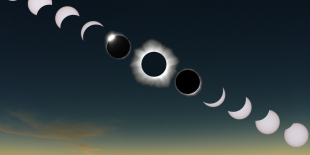
3:00 - 4:00
Estados Unidos
Learn about how solar eclipses come to be, what scientists discover during eclipses, exactly when and where the upcoming eclipse will be best visible, and how to observe the eclipse and the Sun safely.
A rare and dramatic eclipse of the Sun is coming to North America on Apr. 8, 2024. 32 million people living in a narrow path from Western Mexico, through Texas, parts of the Midwest, upstate New York, and a slice of New England will see a magnificent total eclipse, where the Moon completely covers the Sun. Everyone else (an estimated 500 million people, including all of us in the Bay Area) will see a nice partial eclipse, where the Moon covers a good part of the Sun. Fraknoi will also explain why eclipses are total only on Earth.
Andrew Fraknoi, who is sometimes called the “Bay Area’s Public Astronomer,” retired a few years ago as the chair of the astronomy department at Foothill College and still teaches short, noncredit courses on astronomy at the University of San Francisco and SF State. He is the co-author When the Sun Goes Dark, a book for children about eclipses, and the lead author of OpenStax Astronomy, a free online book that is now the most frequently-used, introductory astronomy textbook in the country. He appears regularly on local and national radio, explaining astronomical developments in everyday language, and was named California Professor of the Year in 2007. With several colleagues, he is leading the effort to distribute 6 million free eclipse glasses through 13,000 public libraries across the nation, with support from the Gordon & Betty Moore Foundation. For more on his work, see his website.
Eclipse image courtesy of Rick Fienberg / TravelQuest International / Wilderness Travel. Accessed via this link.

Science
Gain a new perspective on and understanding of the world through programs on the sciences.

